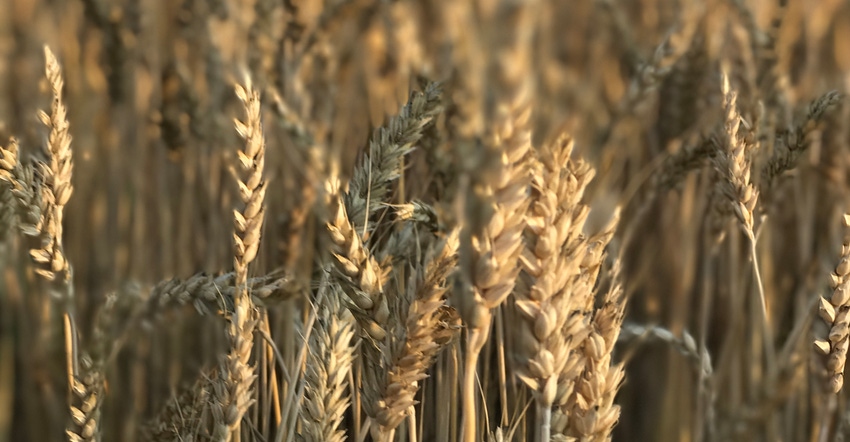
Is it possible that price, weather, quality and yield have joined forces to create a spectacular season for the winter wheat crop in both Michigan and Ohio? The answer is yes, at least at this point in early May.
“The crop is looking good all over the state, and I have been all over the state,” says Dennis Pennington, Michigan State University Extension wheat specialist.
It’s the same for Ohio with 81% of the winter wheat crop rated in good-to-excellent condition at the beginning of May. Michigan had 73% of its crop in those top categories.
“Every farmer I have talked to says, ‘I can't remember a time when the wheat looked this good,’” Pennington says. “There are a few fields that have issues and problems like there is every year, but overall, everybody is optimistic about the wheat crop and yield potential.”
Michigan and Ohio growers raise soft winter wheat. In Michigan, about 70% is red wheat and 30% white, while Ohio is predominately red.
“So far, the season has been very dry, so the risk for diseases has been low,” Pennington says. However, for fields that were planted early and had a lot of fall growth, he has noted some early infections of powdery mildew and septoria. “So, I would definitely encourage growers to scout fields and be looking for those issues,” he says.
Time for fungicides
By the second week of May, most wheat fields are in the critical Feekes 8 growth stage when the flag leaf emerges, says Ned Birkley, MSU Extension educator emeritus and owner of Spartan Ag. Septoria leaf spot favors cool (50 to 68 degrees F) and rainy conditions and can cause significant yield loss, he says. The flag leaf generally provides about 80% of the yield potential of the crop, and the flag-1 leaf provides most of the other 20%.
“Top farmers want to keep all four leaves as green as possible for as long as possible to promote bigger heads and kernels,” Birkley says. “Therefore, most spray is directed to protect the flag leaf from diseases such as septoria and powdery mildew, which reduce grain fill and the size of the grain. The ‘best’ treatment starts with planting resistant varieties. Sprays now at Feekes 8 will help protect the flag leaf, but will not adequately protect the head from late-season diseases.”
All white wheat growers apply the flowering fungicide, Pennington says. “My guess is that 50% to 60% of them also put the flag leaf fungicide on as well,” he says. “The red wheat growers, however, are a mixed bag. We have some that don't put any on and some that watch the Penn State head scab model and apply if the crop is at high risk. But anybody that's growing wheat and trying to go after the higher yields, they're all putting fungicide on at least once, many of them twice, and some of them even three times.”
Gary Wilson, president of the Ohio Small Grains Marketing Program, says he’s not heard of any big alerts regarding diseases in Buckeye country. “Growers are really watching for signs of head scab because that transfers over to vomitoxin, which really discounts wheat [price],” he says.
One concern in Ohio is the frost and snow that hit the region April 21. “Most growers won’t detect frost damage until it heads out, and then you'll see some abnormalities — if it got nipped a little by frost," Wilson says. "But, at this point, I think we escaped any major frost injury. “
As growers inch closer to harvest, Wilson advises to not wait, even if the moisture is a little high, to combine. “We’ve had years where growers were waiting for the moisture to come down, like in 2015, but were met with two or three weeks of rain in July that just crashed quality. Balance your risks, especially if you have the means to dry it — it pays to maintain that quality.”
Wheat increase
Michigan growers planted 580,000 acres of wheat, according to USDA. That’s about 100,000 acres more than the year before, which was plagued with continuous fall rain. Over the past five years, Michigan has averaged about 500,000 acres.
“In 2019, soybean and dry bean harvests were delayed because of rain, and then growers had to deal with poor field conditions to plant wheat,” Pennington says. “That prevented a lot acres from being planted.”
Ohio has 570,000 acres of wheat planted, up 8% from the year before. “But here in northwestern Ohio, Hancock County, where traditionally it’s been a wheat-growing area, we’re about half of what we were 10 years ago,” Wilson says. “We used to be around 40,000 acres, and now we're about 20,000 acres.”
A lot of big farmers don't plant wheat anyone, he says. “But then we've also got a lot of farmers who have been successful with double crop, especially the last three, four years,” Wilson says. “Some have been getting 40-bushel beans after the wheat comes off. However, in recent years July and August have had moisture. If those months are dry, that won’t work as well.”
As some growers intensively manage wheat, with several fungicide and fertilizer applications, Wilson says it’s not uncommon to harvest 120 bushels per acre. “With wheat prices soaring — right now, you can contract new wheat for $7.30 — about 30% of the state is using a management program," he says.
The early harvest wheat crop also allows for manure spreading.
Farmers who wish to enter the National Wheat Foundation contest have until May 15 to submit online entries at wheatfoundation.org.
About the Author(s)
You May Also Like






